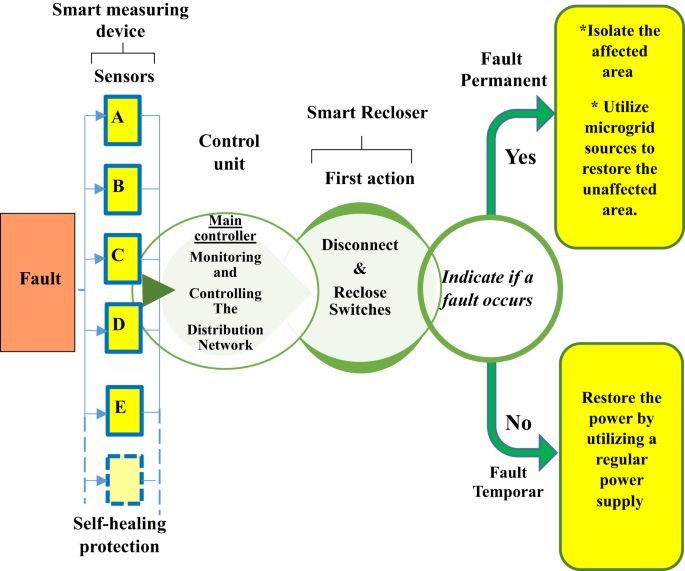Post-fault self-healing
Case (A): application of self-healing methodology on the IEEE 33-bus test system using CYME software
The self-healing methodology was applied to the IEEE 33-bus test system using CYME software, with a fault simulated in Sect. 8 due to its suitability for fault isolation and multiple reconfiguration options to restore power with minimal switch operations. The self-healing protection system responds by opening switches Sw-8 and Sw-9 to isolate the fault, resulting in a power disruption to Sects. 8 through 17, as shown in Fig. 7. This outage affects a total unserved consumer load of 815 kW.
Network reconfiguration was effectively carried out using self-healing techniques to strategically manage switch operations, ensuring optimal load transfer and power restoration for consumers affected by the outage in Sect. 8. The optimal setup for Sect. 8 involves opening switch Sw-9 and closing the normally open tie switch Sw-35, as outlined in Table 4, for scenarios both with and without distributed generation (DG). This configuration facilitates the transfer of 815 kW through the tie line switches after fault isolation. The resulting network layouts are illustrated in Fig. 8.
Case (B): application of the self-healing system using matlab/simulink
In this study, the simulation framework for evaluating self-healing mechanisms in power distribution networks is developed using MATLAB/Simulink, with the IEEE 33-bus test system serving as the foundational topology. This section delineates the configuration of the simulation environment, encompassing the hardware and software infrastructure, alongside a comprehensive description of the model components, including bus configurations, load profiles, power sources, and switching mechanisms.
Central to the simulation is the control unit model, precisely designed in MATLAB/Simulink to coordinate the operation of smart protection devices. The Simulink model represents the dynamic behavior of these devices, offering a graphical representation of their interactions within the distribution network. Key components include bus signal blocks, which emulate protective relays with configurable parameters such as overcurrent settings, time delays, and trip characteristics; circuit breaker blocks, which model the response to fault conditions through controlled opening and closing actions; and switch blocks, which simulate network reconfiguration by isolating faulty segments or redirecting power flow. The control unit block integrates decision-making algorithms, processing inputs from sensors and relays to execute coordinated actions, such as fault isolation or power restoration.
Additionally, a measurement unit block collects and processes real-time system data, providing critical inputs for the control unit’s decision-making process. This model facilitates the simulation of diverse fault scenarios, enabling thorough analysis of device coordination, response times, and the overall efficacy of the smart protection system in enhancing the reliability and stability of the distribution network. Figure 10 shows the Simulink control unit, integrating relays, breakers, and switches.
The configuration of the system components in the Simulink model. (a) The Simulink model with integrating components, system units, relays, breakers, and switches. (b) The bus current and voltage monitoring components in the measurement system unit. (c) The logic unit model diagram in the control system.
The self-healing approach was implemented in MATLAB/Simulink using protective devices capable of receiving remote commands to respond rapidly to faults. In this scenario, a fault is simulated in Sect. 8, as shown in Fig. 11. When the fault occurs, the current exceeds its rated limit, prompting the monitoring unit to detect the abnormal current surge. This triggers a signal to the comparison unit, which evaluates the currents in each feeder segment against the relay settings. To isolate the fault, the comparison unit sends a signal to switch Sw-8, which opens within 0.02 s. Consequently, the power supply to Sects. 8 through 17 is disrupted, resulting in an unserved consumer load of 815 kW.
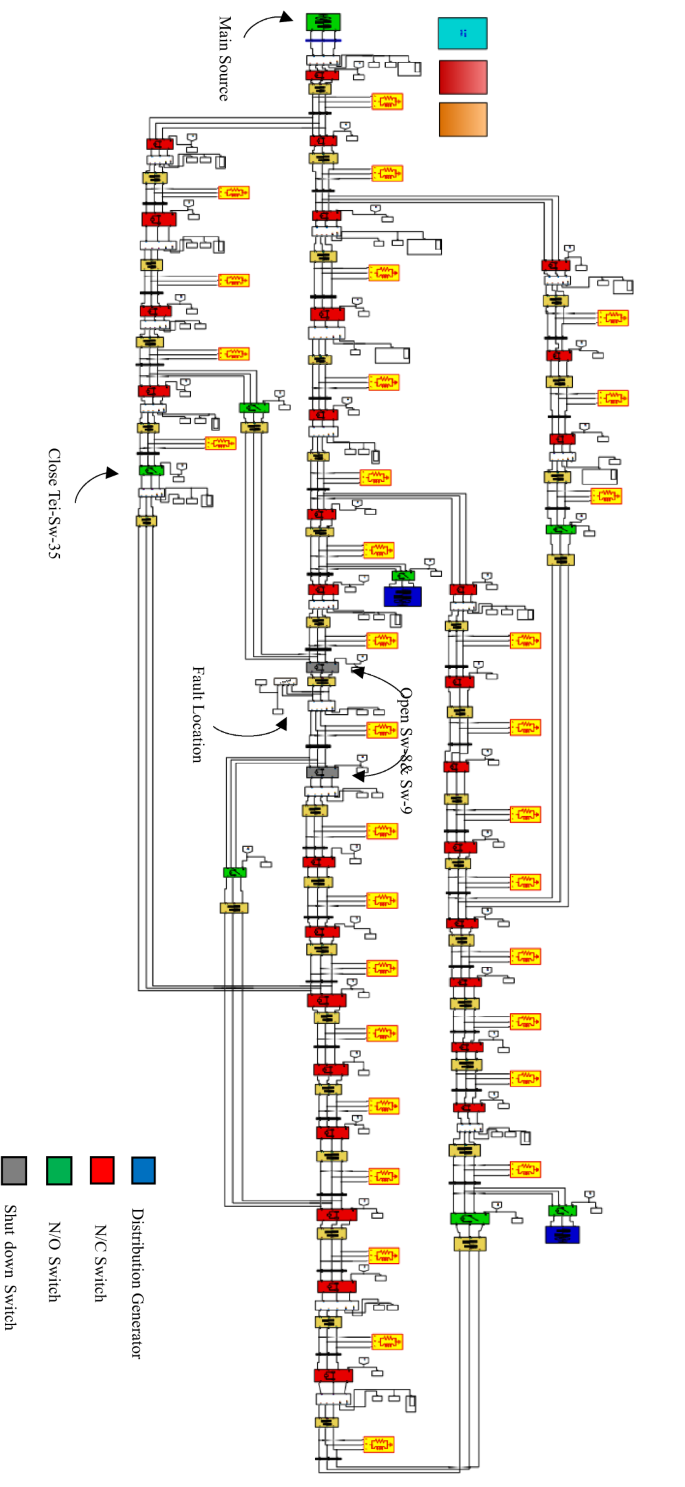
The IEEE 33 bus test system is supported with 2 DGs Simulink mode.
Figure 12 demonstrates that when implementing the self-healing process without distributed generators (DGs), the minimum voltage of 0.90 p.u. presented at bus 17, and the system losses calculated to be 144.97 kW. With the integration of DGs, the minimum voltage improved to 0.973 p.u. at bus 17, and the losses were substantially reduced to 48.6 kW as detailed in Table 4. Figure 12 presents the post-fault voltage profile, while Fig. 13 compares branch currents.
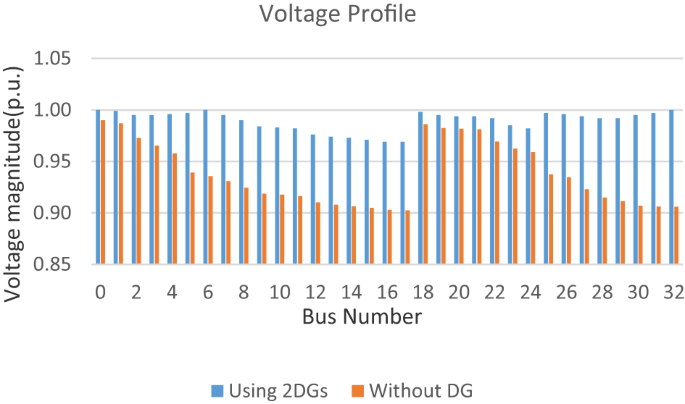
The IEEE 33-bus system voltage profile with and without 2 DGs in MATLAB.
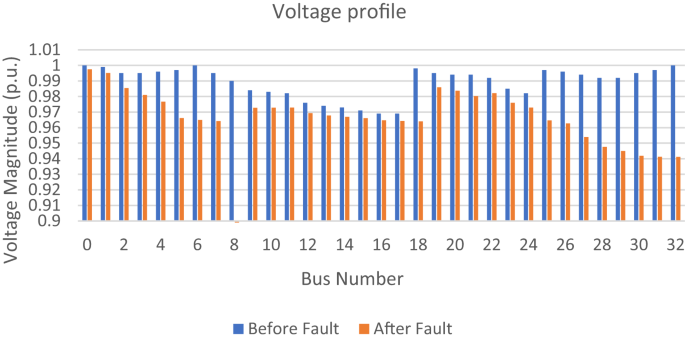
Voltage profile before/after fault isolation with DG.
Figure 13 offers the voltage profile before/after activation of the fault event in the self-healing system. The pre-fault voltage at bus 9, steady at 0.984 p.u., demonstrates the enhanced steady-state condition achieved through optimal DGs placement. Following the fault, the voltage stabilizes at 0.972 p.u. The slight voltage reduction at bus 9 is due to load redistribution and line impedance effects post-reconfiguration, yet it remains within the acceptable range of 0.95–1.05 p.u. Additionally, Fig. 13 indicates that the post-restoration minimum system voltage is 0.94 p.u. at bus 32. This robust dynamic response highlights the system’s capability to maintain voltage stability during fault conditions, reinforcing its reliability as a key feature of a smart grid.
Figure 14 illustrates the branch current loading in the IEEE 33-bus system under two conditions: normal operation and post-fault isolation. During normal operation, the main feeder carries a load current of 106.2 A per phase. Following a fault in section 8 and the subsequent self-healing process with fault isolation, the total recovered load current across the 33-bus system reduces to 74.6 A per phase, as detailed in Table 5.
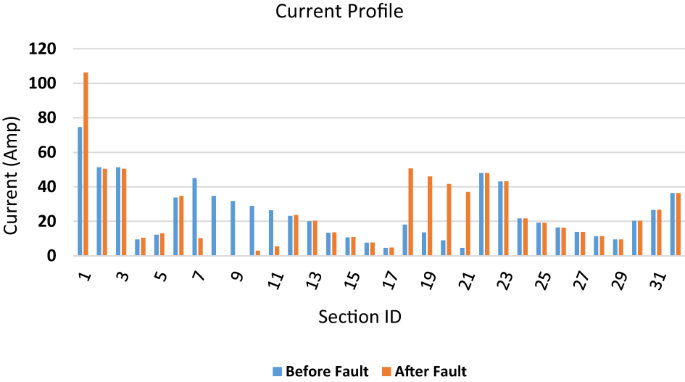
Branch currents before/after fault isolation.
Figure 15 displays a time-domain plot of the voltage magnitude at bus 9 during a fault in Sect. 8, simulated using MATLAB/Simulink. The x-axis represents time in seconds, and the y-axis shows the voltage value in per unit (p.u.). Before the fault, the voltage was stable at approximately 0.98 p.u., reflecting the improved voltage profile due to DGs placed at buses 6 and 32.
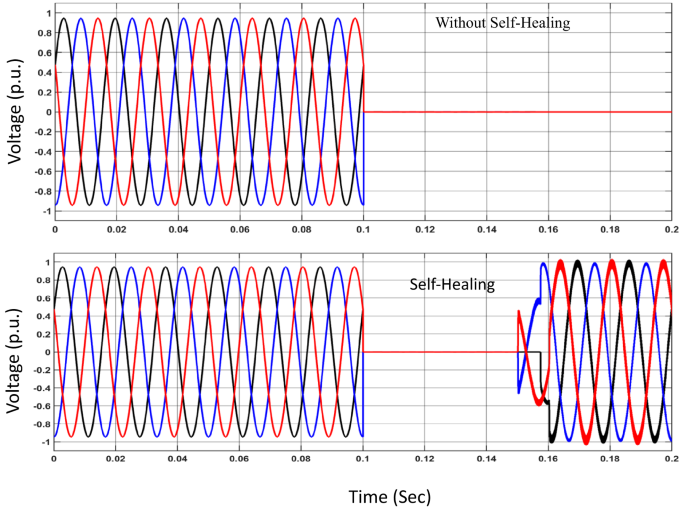
Voltage on bus-bar 9 before and after the application of the self-healing process, using DGs, during a fault occurrence.
At the fault onset (t = 0.1 s.), the voltage drops sharply due to the disturbance. Within 0.02 s., the fault is detected and isolated by opening switch Sw-8, resulting in a transient voltage dip. The self-healing process then activates, opening switch Sw-9 and closing switch Sw-35 to restore power. At t = 0.16 s, the voltage stabilizes at approximately 0.97 p.u., confirming successful power restoration. This rapid recovery, achieved within 60 ms, highlights the effectiveness of the control unit and DG support in mitigating voltage sags and ensuring system stability. During the fault event, the self-healing approach underscores the system’s capability to maintain stability and ensure reliable power restoration. The self-healing system significantly reduced overall power losses by 76% (from 202.66 kW to 48.6 kW).
Although direct comparisons with other studies are limited by the lack of standardized benchmarks for the IEEE 33-bus system, Table 6 compares the quantitative performance of the proposed self-healing framework based on PSO for DG placement with related works in the literature. The comparison includes voltage-profile improvement, loss reduction, and service restoration time. Additionally, a comparison between the base case load conditions before and after optimal DG placement is presented in Table 3.
The proposed self-healing mechanism demonstrates robust performance under varying load conditions and fault scenarios, including multi-point faults and real-time load variations, through its adaptive control strategy and optimized network reconfiguration. It adapts to different load conditions through PSO-based DG placement and network reconfiguration, ensuring voltage stability and minimizing losses.
In fault scenarios, the system effectively handles single-point faults and is also capable of managing multi-point faults using the same control strategy. It utilizes automated switching and centralized control functions for monitoring, fault detection, isolation, and reconfiguration, all managed by a central control unit through fully controlled switches. Specifically, only three switches are used per fault: one bus-bar switch is tripped to isolate the faulty section based on a protection relay signal; the next downstream bus-bar switch is automatically tripped to isolate the faulty line; and finally, the tie switch is closed automatically to restore service to the healthy sections.
